#maasai beadwork
Explore tagged Tumblr posts
Text

Boucles d'oreilles africaines rondes en perles de verre orange et multicolores ::: Timeless Fineries
#bijoux africains#boucles d'oreilles africaines#bijoux ethniques#boucles d'oreilles rondes#bijoux massai#boucles d'oreilles traditionnelles#bijoux exotiques#boucles d'oreilles ethniques#timeless fineries#mode africaine#african jewellery#african earrings#maasai beadwork#ethnic fashion
1 note
·
View note
Link
0 notes
Text
The Princes

Ten years later. When marrying a Prince turns a Queen and a Servant into actual Royalties.
Because Vil deserves a real crown and Jamil deserves to be treated better.
NOW I'M GONNA RANT ABOUT MY CHARA DESIGNS CHOICES AND ALL THE DISCOVERIES I MADE WHILE LOOKING FOR REFS! If you only care about art and funny doodles, you can scroll down for a handful of slices of life.

(Don't worry if you can't read my notes, I'm repeating myself better right under this)
Leona
-Lion: As you may know, one of my grievances with Leona is how his hair doesn't look like an actual mane despite being a lion. While I don't want to stray too far from the canon design with the usual drawings, that's the occasion for me to have some fun with a future version. Give that lion a beard and voluminous hair!
-Hair: First, get those bangs out of his face. Despite Leona being very confident, he still has bangs covering his scarred eye. I wanted him to finally own the aspects of him that may be scary to others (his UM, his scar, etc). I actually went with bangs framing his face similar to the ones he had during his Overblot. I wasn't sure whether to give him dreadlocks or curly hair, but I ended up choosing the free curls decorated with some atebas and braids so that Vil could have more fun styling them.
-Eye: Thanks @aria-faye for the idea, I decided to have his eye gradually lose its capacities with time. From a headcanon that, while the eye wasn't directly touched by whatever attack scarred him, the process of healing still had an impact on it and he gradually lost sight in his left eye years after years.
-Body: Not giving him a dad bod (yet, maybe in another ten years), but definitely giving him more voluminous yet casual muscles. Practical muscles with a healthy dose of fat and tissues. Also giving him two full sleeves of tattoos because I decided he should have much more than just his lion tattoo.
-Clothes: Went full Maasai dressing and Kenyan fabrics and beadworks. If you're not familiar with it, please go check it out, it's GORGEOUS!! Crown is beadwork too. He also has one Arabic styled foot jewellery.
Jamil
-Hair: My first order was to remove his double-faced hairstyle and also remove his bangs from his eye. Make him confident enough to show his whole face. Unlike Leona and Vil, he doesn't really want a crown though (he still feels weird about becoming royalty) so instead he uses a braid as crown. Also gave him a little goatee because I like facial hair and Jafar has a beard too.
-Body: He grew up! While he didn't quite catch up with Leona and Vil, he is now closer to their sizes than before, sitting at around 180cm. He kept his breakdancer/martial artist lean muscles but developed a bit of shoulders.
-Clothes: Went full Arabic dressing and fabrics (once more, go check the fabrics, they are pieces of arts). I gave him floral motifs instead of his usual fire/snake motifs (though he does have a snake earring and a fangs necklace) to symbolise his rebirth/blooming. Like Leona, he has one piece of jewellery that is beadwork.
Vil
-Hair: Here it was a bit tricky. Considering Vil's work, he likely changes hairstyles a lot, going from long to short for his roles instead of his wants. So I leaned into the little things he could add to his hair despite their constant changes, mostly jewelleries, beadworks and wool decorations he stole from his husbands. He also cares a bit less about them looking perfect and is allowing himself to be more natural. He doesn't have any facial hair (yet), keeping a youthful appearance for as long as he can. In another ten years though, he might start looking more and more like his father, beard included.
-Clothes: For Leona and Jamil's mental states, the three of them most likely started living in Sunset Savanna so they wouldn't freeze to death. Vil is well traveled so he can handle most temperatures without trouble, and he is used to dressing up in the local get ups. Here I decided to give him both African dress and Arabic fabric, and likewise both beadwork and golden jewellery. I gave him crown and heart motifs so he can keep being himself despite borrowing a lot from his husbands.
There, I'm done rambling. Here's some doodles, followed by some random headcanons.

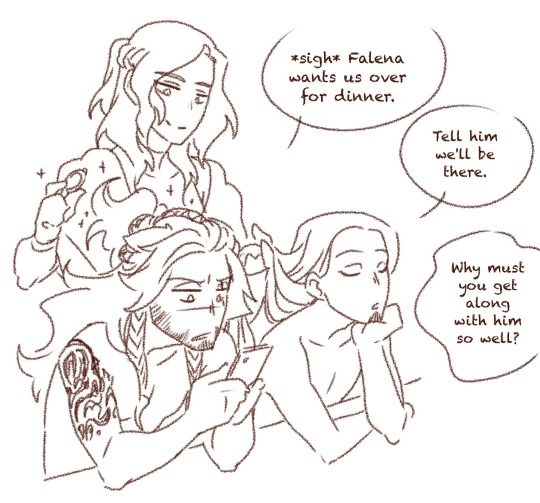


-Vil does his husbands hair every morning and keeps giving them more and more intricate hairstyles. He developed a whole haircare and beard-care products set for them.
-When Vil is away for a movie, Jamil keeps his hair mostly down save for a few accessories.
-Jamil and Falena get along surprisingly well (to Leona's despair). Vil gets along very well with Falena's wife.
-Jamil acts as a Scalding Sands ambassador and still is the one to care for Kalim when he comes to visit, though this time he's doing it because he wants to and not because he has to.
-Vil got used to his new title immediately but Jamil struggles with it a lot. He still has a hard time wrapping his head around the fact that he is no longer a servant.
-The servants at the palace love Jamil because he always makes their job easier.
-Leona finally decided to put his wits to good use and became Falena's advisor. He still fights a lot with Kifaji about the direction to take with the country, but he managed to make some of his ideas heard to help with the staggering inequalities in the country.
That's all for now!
#so... that's officially my longest piece to date#this one took me nearly 10 hours#and I'm considering doing a colored version because Arabic and Kenyan fabrics are so beautiful I swear#won't happen in a while tho#mello's drawings#n2 squad#jamil viper#leona kingscholar#vil schoenheit#javil#leojami#leovil#twisted wonderland#twst#art#my art#analysis#Future!N2
1K notes
·
View notes
Text

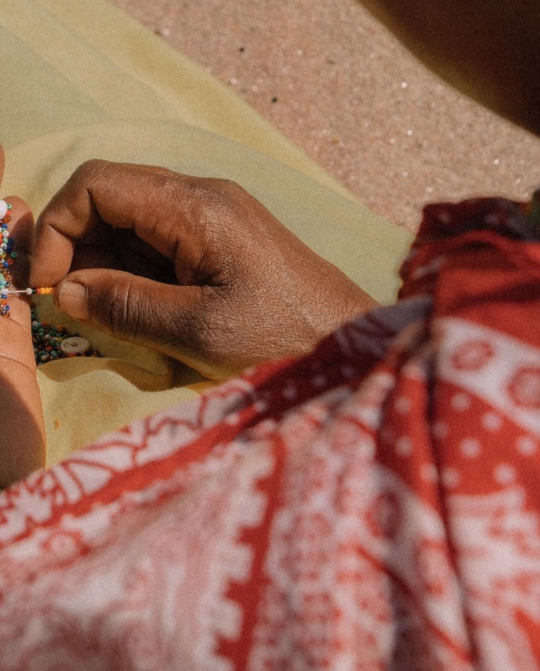
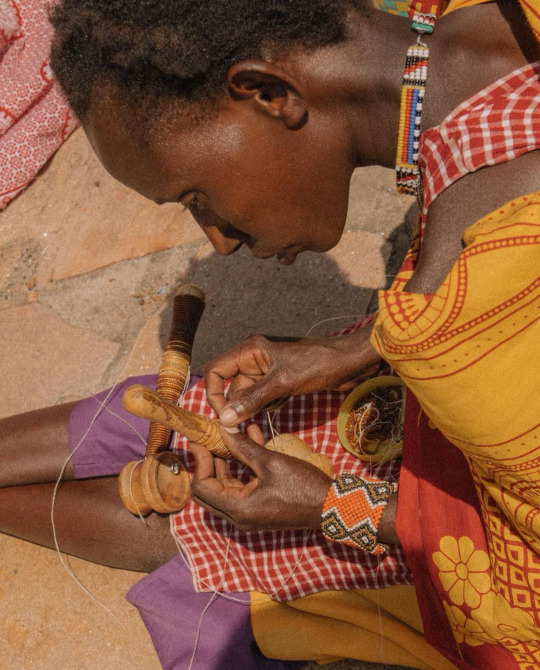

maasai beadwork, kenya
erikaexplores
#maasai mara#kenya#humans#people#portrait#photojournalism#portrait photography#documentary photography#curators on tumblr
43 notes
·
View notes
Text


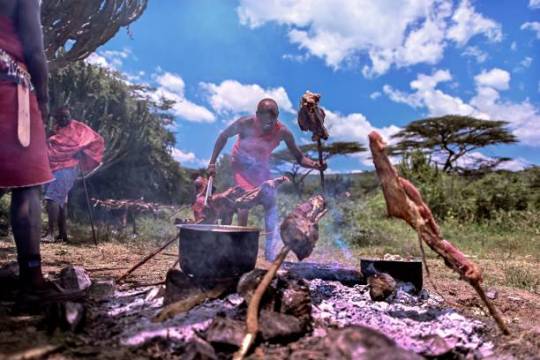
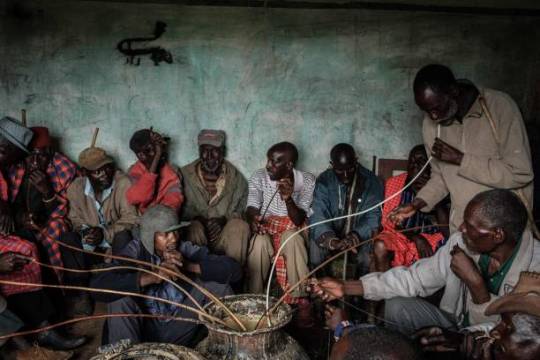
🌍 The Enriching Journey of the Maasai Tribe
The Maasai tribe is a significant community with a unique history. They originated from South Sudan, belonging to the Nilotic ethnic group. Due to unfavorable conditions for livestock farming, they were compelled to migrate in search of grazing land and water for their animals. On their journey, they passed through various regions, including the Ethiopian Highlands and the Great Rift Valley, eventually settling in the fertile lands of the Serengeti and Maasai Mara. Along the way, they encountered various indigenous communities, such as the Samburu, Kikuyu, and Luo, which contributed to the distinctiveness of the Maasai culture.
Today, the Maasai primarily live in Kenya and Tanzania, with an estimated population of around 1 million. They are divided into approximately 16 clans, with the Purko and Loita clans in Kenya and the Parakuyo clan in Tanzania being the most influential in terms of historical impact and size. Despite their geographical separation, the Maasai maintain a shared culture that binds them together.
In Kenya, the Maasai lead a semi-nomadic lifestyle, which contrasts with the more settled Maasai in Tanzania, who now engage in both farming and livestock herding. Their unique identity is immediately visible through their attire. In Kenya, they wear red shukas (blankets) adorned with intricate beadwork, while in Tanzania, the Maasai often wear blue and purple shukas. These variations in attire symbolize their unity in diversity.
Visiting the Maasai offers a unique learning experience. You can participate in their traditional dances, such as the adumu or jumping dance, and listen to elders recount stories of their origins. You will also have the chance to taste their traditional foods, like ugali (maize porridge), traditional drink (known as amarula –a mixture of fresh cow’s milk and cow blood), meat, and milk. Importantly, you will learn about their traditional herbal medicine practices, known as mitishamba. Examples include esititi, used for dental care, various herbs for treating malaria, and other plants for digestive health and body detoxification.
The Maasai tribe offers invaluable lessons in resilience, sustainability, and the importance of cultural heritage. This brief glimpse into their rich history and vibrant culture is just a taste of what this remarkable community has to offer.
✨ Resilience, Unity, and Cultural Heritage -The Maasai Way ✨
For more insight and information on cultural tours and safari experiences, follow us!
10 notes
·
View notes
Text
The Enduring Spirit of the Maasai People
The Maasai people, with their vibrant red shukas (robes) and rich cultural traditions, are a captivating aspect of East Africa. Inhabiting parts of Kenya and northern Tanzania, they've captured the world's imagination for centuries. Let's delve into their fascinating world and explore what makes them unique.
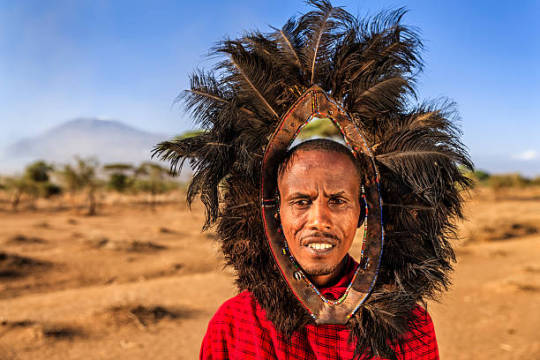
A Legacy of Pastoralism
Traditionally, the Maasai are semi-nomadic pastoralists. Their lives revolve around herding cattle, sheep, and goats. These animals are central to their way of life, providing sustenance, social status, and dowries for marriage. The Maasai have an intimate understanding of their environment, moving their herds to find the best grazing lands based on seasonal changes.
Deeply Rooted Traditions
Maasai society is complex and age-based. Men progress through a series of age sets, each with specific roles and responsibilities. Young warriors, known as Moran, are known for their bravery and elaborate beadwork. Women play a crucial role in building and managing the communities (manyattas) and raising children.
Living in Harmony with Nature
The Maasai have a deep respect for nature, believing in a strong connection between themselves, their livestock, and the land. Their traditional religion emphasizes living in balance with the environment. This respect is evident in their intricate understanding of wildlife behavior, allowing them to coexist with animals like lions and zebras.
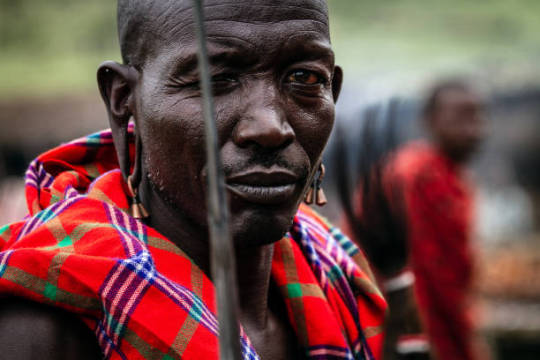
Facing the Winds of Change
The Maasai way of life faces challenges in the modern world. Encroachment on their grazing lands, drought, and the lure of a more sedentary lifestyle threaten their traditional practices. However, the Maasai are a resilient people. Many communities are adapting, engaging in ecotourism and cultural preservation efforts to secure their future.
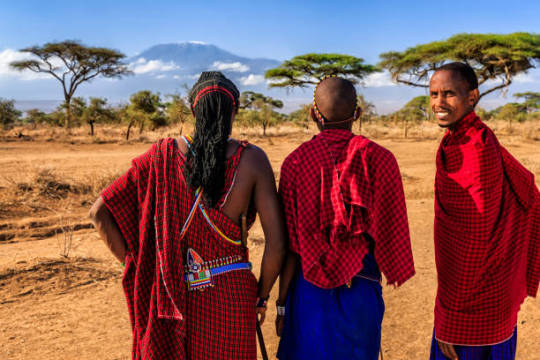
Experiencing the Maasai Culture
If you're fortunate enough to visit East Africa, consider visiting a Maasai community. Witnessing their dances, learning about their traditions, and supporting their businesses can provide a glimpse into their remarkable culture and contribute to its preservation.
The Maasai people are a testament to the power of tradition and resilience. Their enduring spirit and respect for nature are an inspiration for us all.
#ugandian knuckles#tourist#tourism#wild animals#tour#Adventure#photography#beach#safari#africa#Nairobi#Uganda#Kenya#Masai Mara#beaches#Wanderlust#east africa#Travel Photography#travel blog#tanzania#tanned#zanzibar#tangled#tanzanite#kenyan#kenya moore#beachlife#Kenya Safari#Nairob#travel
3 notes
·
View notes
Text
Some Interesting Facts About Maasai Jewelry That You Should Know
Maasai jewelry is a traditional beadwork that holds a cultural and symbolic significance within the Maasai culture. It represents beauty, strength, tradition, warriorhood, marriage, social status, and love toward cows. The beads' colors are used for decorative purposes and represent various aspects of the wearer's identity.
These days, many people love Maasai beadwork that is used to create accessories like jewelry, belts, and sandals, as well as home décor items and many household tools. This is also one of the most preferred gift items that people give to their loved ones.
In this blog, let's explore some interesting facts about Maasai Beadwork and what each color in the bead symbolizes.

Some interesting facts about the Maasai Beadwork
1. Represent Maasai cultural values and traditions
Women specifically craft these beadworks. So, they must learn beadwork. Both men and women wear this jewelry in every cultural practice, like weddings, rituals, and community events.
2. Existed for centuries
Maasai Jewelry are traditional adornments that date back to centuries. In the 19th century, people from all over the world got to know about this jewelry after trading with other tribes.
3. Beads weren't used to make ornaments
Maasai women initially used dried grass, sticks, clay, seeds, and shells to craft these traditional adornments. With time, women started using attractive beads made of plastic and glass to make jewelry, which they traded with other communities.
4. Worn as per age and social status
People with higher social status wear more colorful beads. Unmarried women wear large flat beaded discs on their necks while dancing to show their grace and flexibility. Women getting married wear a heavily beaded neck piece on their wedding day. Married women wear long necklaces with blue beads.
5. Different colors have different meanings
In Maasai beadwork, beads have different colors, each with a special meaning. Both Maasai men and women wear them to express their wealth. Continue reading this blog to know more about what each bead color signifies.
The Symbolism of Maasai Beadwork
At the time of the marriage, the mother crafts a special wedding collar representing their village. Several beaded strands hang off the traditional wedding collar and symbolize the dowry in cows. This will be handed over to the bride's family. Women also wear similarly layered collars every day or in ceremonies to represent wealth and beauty.
In Maasai culture, beads are a form of adornment that can be worn every day in ceremonies and rites of passage. These are also given to the visitors to show gratitude and respect.
Now let's explore more about what each color bead in the jewelry represents of the Maasai culture.
Red: Symbolizes the daily strength, unity, and bravery that Maasai people face.
Blue: Symbolizes energy and sustenance and represents the color of the sky.
Green: Symbolizes the color of the grass that provides nourishment and food production for the people and their livestock.
Orange: Symbolizes warmth, generosity, friendship, and hospitality. It also represents the color of the gourd used to serve milk to guests and welcomes visitors to their houses.
Yellow: Represents growth and fertility, signifies the color of the sun.
White: Symbolizes health and purity and represents the color of cow's milk which provides nourishment.
Black: Symbolizes unity, harmony, and solidarity. It represents the color of the people and the daily struggles that they face.
Conclusion
Maasai jewelry is a beautiful artwork, including colorful beaded ornaments objects like earrings, ear flaps, necklaces, bracelets, belts, and headbands. It is more than jewelry for the Maasai people. It is a beautiful way to express their feelings, wealth, and testament of their skills. Today, these beaded artworks have become very popular all around the world. Visit African Bazaar and get your own Maasai beadwork at reasonable prices. They also create beautiful and unique handmade items like sandals, jewelry, dress, and so on, which can help you get a traditional look. So, hurry up. Shop now.
2 notes
·
View notes
Text
Trips With a Purpose - Tanzania’s Best Conservation & Cultural Safaris

By 2025, conservation safaris Tanzania are no longer niche; they are the new norm for tourists looking more profound, meaningful relationships with the locations they visit. These are Trips with a Purpose combining intense animal experiences with community involvement and environmental responsibility, not just vacations. Tanzania has been a world leader in hosting safaris protecting habitats, empowering local people, and supporting sustainable development as travellers become more aware. Such encounters are changing the scene of contemporary Tanzania Safari Tours by mixing adventure with advocacy in the most motivating manner.
Safaris that Empower - The Growth of Ethical & Community-Based Travel
Community-based tourism in Tanzania is changing to provide genuine cultural interaction and local empowerment. Now travellers may participate in ethical safari experiences including village tours, traditional artisan displays, and storytelling sessions led by local elders. Among the main characteristics of these eco-friendly safaris are:
Working with Maasai communities to protect the legacy
Learning traditional skills including beadwork, hunting, or bush medicine
Supporting local businesses producing tourist income
Participating in ethical safaris helps visitors directly support responsible travel practices that give people and the environment a top priority.
Conservation on the Ground: Wildlife Projects Deserving Support

Critical conservation projects are at work across Tanzania National Parks safeguarding endangered species, rehabilitating habitats, and tracking wildlife populations. During their safari experience, visitors can see and even support these initiatives. Popular safari add-ons motivated by conservation include:
Visiting Serengeti anti-poaching outposts to learn about field operations
Supporting rhino protection efforts in Ngorongoro Conservation Area
Bird monitoring and lion collar tracking with researchers
These hands-on experiences let visitors interact with the land and protect it for future generations, redefining impact travel.
Voluntourism in Action: Supporting Wildlife Rehabilitation Centers
In Tanzania, voluntourism is increasingly seen as a significant component of sustainable tourism. It lets visitors contribute their talents to animal rescue and rehabilitation while learning more about conservation efforts. Available in rehabilitation centres are chances to:
Help with feeding and care of orphaned or injured animals
Watch health monitoring routines and veterinary procedures
Join conservation education programs or awareness campaigns
Such engaging experiences offer a different perspective on Tanzania Safaris, one that emphasises healing and coexistence.
Eco-Friendly Lodges: Where Comfort Meets Preservation
Many opulent safari camps in Tanzania have maintained comfort while using low-impact policies. Designed to fit with their surroundings, these eco-lodges Serengeti use solar energy, water recycling, and organic architecture. Important aspects of eco-conscious lodges are:
Plastic-free policies and zero-waste goals
Sourcing ingredients from nearby farms and cooperatives
Community employment and guide training programs
These qualities fit exactly with current Tanzania Safari Planning, so demonstrating that luxury and sustainability may coexist together.
Responsible Safari: How to Travel Mindfully
Though Tanzania has many ways to explore purposefully, careful planning makes all the difference. Choosing ethically as a traveller will improve not only your experience but also your influence. Advice on purposeful Travel In Tanzania:
• Select private companies that value community influence and conservation
• Follow wildlife viewing principles and steer clear of single-use plastics • Back locally owned hotels and craftsmen This deliberate attitude to Travel in Tanzania guarantees that the experience helps everyone concerned and deepens knowledge.
Final Thoughts: Where Adventure Meets Goal
Conservation safaris in Tanzania are altering the future of African tourism as well as the visitor as they are evolving. From village collaborations to anti-poaching patrols, these safaris are designed to leave something behind: support, respect, and sustainability. Trips with a Purpose are helping to create more responsible, enriching worldwide people in a society where travel is no longer only about escape. Leading the way in providing discreet, eco-conscious, and culturally sensitive Safari Tours in Tanzania that honor it's genuine core is African Scenic Safaris. Their custom-made safaris give significance to every mile whether your interests are ethical travel, cultural connection, or wildlife protection.
#tanzania conservation and cultural safaris#best tanzania conservation and cultural safaris#tanzania safari tours
0 notes
Text
WOII: Week 9 - Cultural Materialism
The definition of “Cultural Materialism”
“A theoretical approach that examines how material conditions, like technology and economics, shape culture and society, viewing culture as a product of these material forces”. In other words, how the way people live affects the culture. The word “Culture” can be defined from different views such as beliefs(religion), behaviours(passed down from generations), norms(public boundaries), values(respect) and social systems(family).
(Summarized) Cultural materialism varies by country, shaped by resources, technology, and economic systems, and as it evolves over time, it influences the surrounding environment.
“How does it fit into the society?” “What benefits and causes does it provide?” and “What element should we implement to benefit the society?”
In today’s class activity, in groups of 4, we are given a task to create an ad, reimagining different universes and what product/goods benefits them. The point of this activity is to be intentional with reasonings, consider both good and bad, and how/what you think will affect the society. While also considering target audience, market, and identity. As a group we decided to choose Wakanda having their own fashion style.
The goal was to establish Wakanda’s unique identity by utilizing vibranium, with tourism as a secondary benefit. These outfits will be made by robotic tech as it ensures precision when mass production is involved.Serving as a connection to ancestors, reinforcing the belief that history and identity should not be lost in modernisation. They used tribal design and handcrafted textiles, fused with elements from different African cultures, such as; Maasai beadwork (Kenya & Tanzania), Ndebele patterns (South Africa), Kente cloth (Ghana) and Musd cloth (Mali). Bold silhouettes and warrior-like aesthetics to symbolize power, showing patriotic and pride. Slogans such as “wakanda kultuur”,”wakanda mode” or having an upbringing vibe to build emotional attachment and pride towards local products.


Examples with similar functions :

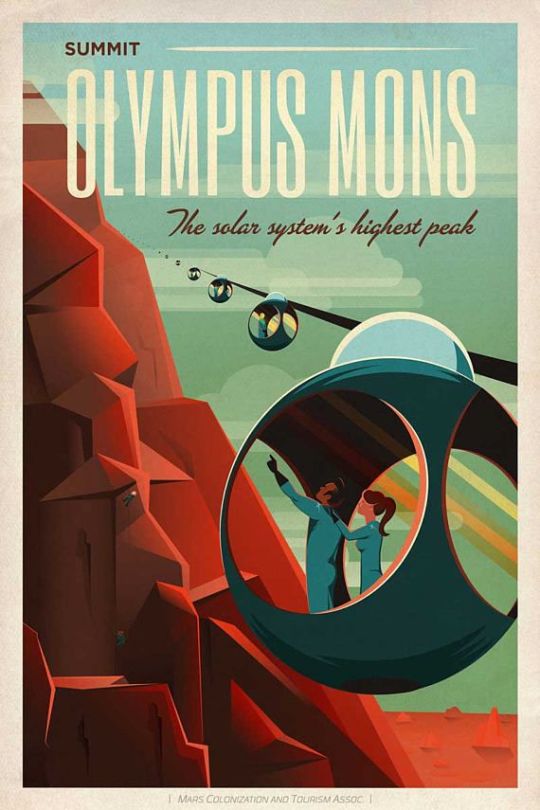
(305 words) References : Crossman, Ashley. “Definition of Cultural Materialism.” ThoughtCo, 15 Oct. 2019, www.thoughtco.com/cultural-materialism-3026168#:~:text=Cultural%20materialism%20is%20a%20theoretical,and%20worldviews%20that%20predominate%20society
0 notes
Text
How Enjoyable Are Tanzania Cultural Tours?
A vacation spot known to offer chances of viewing stunning wildlife, mesmerizing landscapes and enjoy safaris is Tanzania. As it has rich cultural heritage as visitor one can enjoy and experience the varied traditions, languages and life styles. If one is part of Tanzania cultural tours, it is possible to interact with locals, understand the ancient customs, and view the vibrant Tanzanian culture. Let us discuss why such cultural tours in Tanzania offer a memorable vacation.

Immersion in Traditional Maasai Culture
Visiting a Masai community is one of the significant highlight of such cultural tour in Tanzania. You will be amazed having a look at the unique attire, jumping dance, and life-style. They are known to welcome guests with open arms. You can participate in their daily activity and understand their life-style. You can help them to graze the cattle, make beadwork and learn the warrior dance. The interactions will help you to appreciate their life-style and understand the customs passed down through generations.
Exploring the Hadzabe and Datoga Tribes
For those intrigued by ancient ways of life, a visit to the Hadzabe and Datoga tribes near Lake Eyasi is a must. The Hadzabe are among the last remaining hunter-gatherers in Africa, and visitors can join them on a hunting expedition, learning survival skills and experiencing their deep connection with nature. The Datoga people, skilled blacksmiths, showcase their metalworking craftsmanship, producing jewellery and tools using traditional methods. These encounters offer a rare glimpse into Tanzania’s indigenous cultures.
Visiting Vibrant Local Markets
Tanzanian markets are a feast for the senses. Places like the Kariakoo Market in Dar es Salaam and the Arusha Central Market provide visitors with an authentic shopping experience. From colorful fabrics and handmade crafts to exotic spices and fresh produce, exploring these bustling marketplaces offers insight into local trade, flavours, and daily life.
Cultural Festivals and Traditional Music
Tanzania is home to lively festivals that celebrate its cultural diversity. Events such as the Bagamoyo Festival of Arts and Culture feature traditional dance performances, drumming sessions, and Swahili poetry. Music lovers can enjoy the rhythms of Taarab and Bongo Flava, which blend African, Arabic, and Western influences. Attending these festivities allows travellers to experience the joy and creativity of Tanzanian artistic expression.
Culinary Delights and Traditional Cuisine
Food is an integral part of any cultural tour, and Tanzania’s cuisine is a delightful experience. Visitors can savor local dishes such as Ugali (a maize-based staple), Nyama Choma (grilled meat), and Zanzibar’s famous spiced rice, Pilau. Engaging in cooking classes or dining in local homes enhances the cultural experience, offering a true taste of Tanzania’s culinary heritage.

Tanzania cultural tours with AAA Express Adventure go beyond sightseeing—they provide a profound connection to the country’s history, traditions, and people. The cultural tour is not just enjoyable; it is a transformative journey that leaves travellers with a deeper appreciation of the country’s rich and diverse heritage. Call +255 27 2545823 to plan your tour.
0 notes
Text
Best Dresses for Men in Kenya Stylish and Comfortable Choices for Every Occasion

When it comes to fashion, men are often seeking pieces that offer both style and comfort. Whether it’s for a formal event, a casual outing, or just day-to-day wear, finding the best dresses for men in Kenya can be a fun yet challenging task. With a range of local trends and international influences, Kenya's fashion scene is evolving rapidly. Men in Kenya are increasingly looking for outfits that reflect their personal style, offer versatility, and suit the country’s diverse climates and lifestyles.
Here are some of the top dress styles for men to consider when looking for fashionable attire in Kenya.
1. Casual Dresses for Everyday Comfort and Style
Casual dressing is essential for men who want to stay comfortable while maintaining a stylish appearance. In Kenya’s warm climate, the key to choosing casual dresses is focusing on breathable fabrics that will keep you cool throughout the day. Lightweight cotton and linen shirts, paired with well-fitted trousers or chinos, are perfect choices for a relaxed, yet put-together look.
For more laid-back days, polo shirts and short-sleeve shirts in pastel colors or subtle prints are popular. They pair well with denim jeans or shorts, making them ideal for a lunch date or a casual stroll. Add a good pair of sneakers or loafers, and you have an easy yet fashionable ensemble that works for a variety of settings. Casual dresses for men in Kenya often incorporate bold prints, reflecting the country's vibrant culture, so don’t be afraid to experiment with colors and patterns.
2. Business Attire: Smart and Professional Dresses for Men
Business attire is a must for men attending formal meetings, interviews, or working in office environments. In Kenya’s corporate world, men are expected to dress smartly, with many opting for classic dress shirts, trousers, and tailored suits. When choosing a suit for business occasions, go for neutral colors like black, navy, and grey. These colors are versatile and sophisticated, and they can easily transition from day to night.
For the tropical climate, lightweight wool or blended fabric suits can help maintain a crisp look without feeling too hot or uncomfortable. Pairing a fitted suit jacket with a dress shirt in a solid color or light pattern will elevate your look, and adding a tie can complete your professional appearance. Business attire in Kenya allows men to blend traditional looks with modern twists, as seen in some local designers’ creations, which incorporate local fabrics into Western-style suits.
3. Traditional Kenyan Outfits: A Celebration of Culture
Kenya’s rich cultural heritage is reflected in the various traditional garments worn across different communities. For men who want to embrace their roots, traditional Kenyan dresses are an excellent way to show pride in their culture. Outfits like the "kanzu," worn by Swahili men, and "shukas" worn by Maasai men, offer a distinctive style that stands out.
The "kanzu" is a long, white robe, often worn for formal occasions or ceremonies. It can be paired with a simple shirt or decorated with intricate embroidery, depending on the event. On the other hand, the Maasai shuka is a colorful, plaid fabric worn by the Maasai people, perfect for casual gatherings or community events. These garments are not just about looking good—they carry deep cultural significance and are often made from local materials.
In addition, Kenyan fashion designers have seamlessly blended traditional elements with contemporary styles, resulting in unique dresses that appeal to men who want to express their cultural identity with a modern twist. Incorporating elements like beadwork or traditional prints into modern designs is becoming increasingly popular, especially for weddings and other significant celebrations.
4. Party Dresses and Night Out Styles for Men
When it comes to partying and attending social events in Kenya, men often want to go for something a bit more adventurous and bold. Party dresses for men are all about making a statement while remaining fashionable. For a night out in Nairobi’s vibrant club scene or at a local celebration, men often opt for sleek, fitted dresses in dark colors like black, deep blue, or metallic tones. These dresses are often paired with dress shoes or trendy boots.
Another popular option for night outs is the stylish blazer. The blazer can be dressed up or down, depending on the vibe of the event, and adds an instant layer of sophistication. Whether you’re heading out for dinner, a concert, or a private event, choosing a well-tailored blazer over a crisp shirt can ensure you look sharp while enjoying the festivities.
For the Kenyan climate, it’s important to keep the weather in mind when choosing night-out attire. Lightweight fabrics are ideal, and pairing them with accessories like watches or cufflinks can add an extra touch of refinement. For those who want to turn heads, experimenting with patterns or incorporating statement colors into your party outfit can be a fun and stylish way to stand out.
Conclusion: Discover Your Perfect Style with Kings Collection
Finding the best dresses for men in Kenya involves a mix of personal style, practicality, and embracing the vibrant culture of the country. Whether you’re looking for a casual outfit, business attire, traditional garments, or something for a night out, there is a variety of choices to suit every occasion and taste. The fashion scene in Kenya continues to evolve, bringing in more unique styles that reflect global trends while honoring local traditions.
If you’re looking for high-quality, fashionable, and affordable options, Kings Collection offers a curated selection of dresses for men that will suit any occasion. From tailored business suits to stylish casual outfits and traditional wear, Kings Collection is dedicated to bringing the best in men’s fashion to Kenya. Visit us and discover pieces that will enhance your wardrobe and elevate your style.
0 notes
Text

Boucles d'oreilles africaines Massai en forme de gouttes ::: Timeless Fineries
#bijoux africains#boucles d'oreilles africaines#bijoux massai#boucles d'oreilles perlées#mode africaine#timeless fineries#bijoux ethniques#boucles d'oreilles tribales#bijoux exotiques#boucles d'oreilles multicolores#african earrings#maasai beadwork#african fashion#ethnic jewellery
1 note
·
View note
Text
The Best of Both Worlds: Exploring Wildlife and Culture on Safari
At Matukio Adventures, we believe that every journey should be more than just a trip—it should be an unforgettable experience that connects you to the heart and soul of a destination. Our cultural wildlife safaris offer you the best of both worlds, combining the thrill of encountering Africa’s majestic wildlife with the rich cultural traditions of its people.
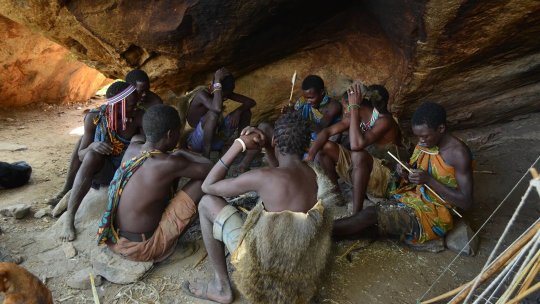
Imagine starting your day with a breathtaking game drive, spotting lions, elephants, and giraffes in their natural habitat. As the sun sets, we take you into local villages where you’ll meet the incredible communities who have coexisted with this wildlife for generations. From their vibrant dances to their intricate beadwork, the stories they share are as captivating as the wildlife itself.
At Matukio Adventures, we are passionate about creating authentic connections. During our cultural wildlife safaris, you’ll have the chance to learn directly from the Maasai, Hadzabe, or Chagga communities, depending on your destination. Whether it’s learning traditional hunting techniques, tasting local cuisines, or participating in daily rituals, we ensure that your cultural immersion is as genuine as it is inspiring.
What sets our safaris apart is our commitment to sustainability and respect for local traditions. We work closely with communities to ensure that our visits not only celebrate their culture but also contribute to their well-being. When you travel with us, you’re not just seeing Africa—you’re supporting it.
Of course, no safari is complete without awe-inspiring wildlife encounters. With our expert guides, you’ll venture into iconic parks like the Serengeti and Ngorongoro Crater, where the Big Five roam freely. But what truly makes our cultural wildlife safaris special is how we intertwine these natural wonders with the stories and traditions of the people who call these lands home.
At Matukio Adventures, we’re not just your guides; we’re your companions in discovery. We design every safari with care, ensuring you leave with memories that will last a lifetime. Whether you’re a first-time traveler or a seasoned explorer, our cultural wildlife safaris promise a journey unlike any other—one that lets you experience the beauty of Africa through its animals and its people.
Let us take you on this incredible adventure. With Matukio Adventures, the best of both worlds awaits!
0 notes
Text
Celebrating Kenyan Culture in Your Profile Picture: Creative Ideas for a Memorable PFP
Your profile picture is more than just a selfie; it’s a canvas for self-expression and a chance to proudly shout out your heritage. What better way to do this than by drawing on the rich palette of Kenyan culture? From the vibrant beadwork of the Maasai to the bold patterns of Kikoy fabric, Kenya’s diverse traditions and tribes offer a treasure trove of elements that can bring color and meaning…
0 notes
Text
How Tourism Is Protecting Kenya’s Wildlife And Communities
In the heart of Africa lies a land of breathtaking beauty, where majestic wildlife roams freely across vast savannas and vibrant cultures thrive amidst stunning landscapes. Kenya, known for its iconic wildlife and rich cultural heritage, has long been a dream destination for travelers seeking adventure and discovery. But beyond the allure of its natural wonders, Kenya is also a place where tourism plays a vital role in protecting the environment and empowering local communities.
At Kiboko Tours and Travel, we believe in the power of responsible tourism to create positive change. Through our commitment to sustainability and community engagement, we are not only offering unforgettable experiences to our guests but also making a meaningful impact on the land and people of Kenya.
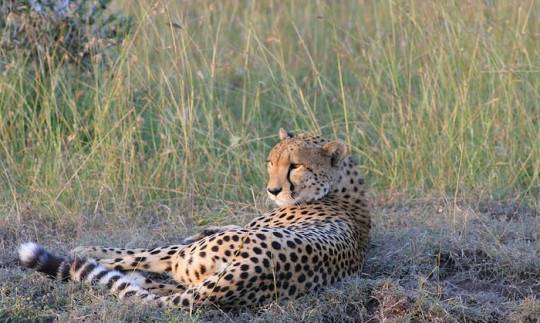
But conservation is not just about protecting wildlife; it’s also about supporting the communities that coexist with these magnificent creatures. That’s why Kiboko Tours and Travel is deeply committed to empowering local communities through sustainable tourism initiatives. From providing employment opportunities to investing in education and healthcare, we strive to ensure that the benefits of tourism are shared equitably among all members of society.
One shining example of our commitment to community empowerment is our partnership with local artisans and entrepreneurs. Through initiatives like our Maasai Beadwork Project, we are helping traditional artisans to preserve their cultural heritage while also providing them with a sustainable source of income. By purchasing handmade crafts directly from local artisans, our guests not only take home a unique souvenir of their journey but also contribute to the economic development of the communities they visit.
But perhaps the most powerful impact of responsible tourism is the way it fosters a deeper connection between travelers and the places they visit. By immersing themselves in the local culture, engaging with community members, and learning about the challenges they face, travelers gain a newfound appreciation for the beauty and resilience of Kenya and its people. And in turn, they become ambassadors for conservation and sustainable development long after they return home.
As we look to the future, the importance of responsible tourism in Kenya cannot be overstated. By choosing to travel with companies like Kiboko Tours and Travel that prioritize sustainability and community engagement, travelers have the opportunity to make a positive difference in the world while experiencing the trip of a lifetime. Together, we can ensure that Kenya’s natural wonders and cultural treasures continue to inspire and delight generations to come.
#WildlifeConservation#SustainableTourism#ProtectKenya#WildlifeProtection#EcoTourismKenya#SaveWildlife#KenyaTourism
0 notes
Text
Exploring the Rich History Behind African Paintings for Sale
Exploring the rich history behind African paintings for sale offers insight into the continent's deep cultural and artistic traditions. African paintings often reflect spiritual beliefs, daily life, and ancestral connections, with each region showcasing unique styles and techniques. From vibrant colors to symbolic motifs, these works of art capture centuries of storytelling and heritage, making them a meaningful addition to any collection, while celebrating Africa's diverse artistic legacy.
Origins of African Paintings for Sale: A Deep Dive into Ancient Traditions
African paintings for sale often trace their roots back to ancient traditions, where art was deeply intertwined with daily life and spiritual practices. Traditional African art served not just as decoration but as a means of communicating with the divine, representing ancestral spirits, and documenting historical events. Each region and culture within Africa has its unique artistic expressions, from the intricate beadwork of the Maasai to the symbolic carvings of the Yoruba.
The Influence of Colonialism on African Paintings for Sale
Colonialism had a profound impact on African paintings for sale, as European powers imposed new styles and techniques on indigenous art forms. During this period, many traditional methods were suppressed, but African artists adapted by blending their traditional practices with European influences. This fusion led to the emergence of new artistic movements that have since become a significant part of the African art market.
The Role of African Paintings for Sale in Post-Colonial Identity
Post-colonial Africa saw a resurgence in traditional art forms as nations sought to reclaim and redefine their cultural identity. African paintings for sale from this era often reflect a sense of pride and cultural rejuvenation. Artists began to explore themes related to independence, heritage, and the socio-political landscape of their countries, offering a rich tapestry of narratives through their works.
The Emergence of Contemporary African Paintings for Sale
In recent decades, African paintings for sale have gained international acclaim as contemporary African artists break new ground and challenge conventional boundaries. Artists like El Anatsui and Wangechi Mutu have garnered global attention, bringing African art into mainstream galleries and auctions. This global recognition highlights the evolving nature of African art and its relevance in the contemporary art world.
Understanding the Symbolism in African Paintings for Sale
Symbolism plays a crucial role in African paintings for sale, with many artworks featuring intricate patterns and colors that hold specific meanings. These symbols can represent everything from social status to spiritual beliefs and are often used to convey messages or tell stories. By exploring the symbolism in these paintings, buyers can gain a deeper appreciation of the cultural and historical significance behind each piece.
How to Identify Authentic African Paintings for Sale?
With the growing popularity of African art, distinguishing authentic pieces from reproductions or forgeries is essential for collectors. Authentic African paintings for sale are often characterized by their unique styles, materials, and techniques. Understanding the provenance of the artwork and the artist's background can help ensure that collectors are purchasing genuine pieces that reflect the true essence of African art.
The Future of African Paintings for Sale: Trends and Innovations
The future of African paintings for sale is bright, with emerging artists and new trends shaping the art market. Innovations in style and technique continue to evolve, blending traditional influences with modern aesthetics. As the global art community continues to embrace African art, the market for these paintings is expected to expand, offering collectors new opportunities to explore and invest in this dynamic and diverse art form.
Conclusion
Exploring the rich history behind African paintings for sale provides valuable insights into the cultural and artistic heritage of Africa. From ancient traditions to contemporary innovations, African art offers a vibrant and multifaceted perspective on the continent's history and identity. By understanding the historical context and current trends, collectors and enthusiasts can fully appreciate the significance and beauty of African paintings for sale.
0 notes